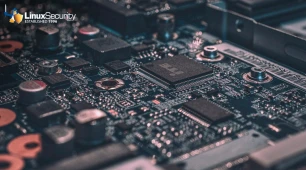
Linux Kernel 6.10 introduced an impressive feature to strengthen the security of the Trusted Platform Module (TPM). Bus encryption and integrity protection safeguard it against potential interposers or sniffing attacks against TPM. Due to performance bottlenecks associated with this feature, the Linux 6.12 update introduced an option to disable its protection. The tpm.disable_pcr_integrity= kernel command line parameter was added to disable PCR integrity protection. PCR integrity protection is enabled by default for Linux x86_64 systems.
In this article, I'll explore the benefits and drawbacks of TPM bus encryption and integrity protection and weigh the pros and cons of opting out, helping you balance security and performance for your Linux systems.
Advantages of TPM Bus Encryption and Integrity Protection
 Source: Phoronix Implementing TPM bus encryption and integrity protection offers numerous benefits, primarily increased security. Encrypting data transmitted between a TPM and the system bus makes it much more difficult for malicious entities to intercept and manipulate this sensitive data. Encryption and integrity checks protect against TPM sniffing attacks involving intercepting and analyzing signals on the TPM bus to retrieve sensitive information. Integrity protection ensures that any attempts at altering data are detected, further fortifying the system against threats like theft of sensitive information or compromise by hackers. Likewise, TPM plays an instrumental role in attesting the integrity of systems by securely recording measurements (PCR extend operations). Integrity protection ensures that measurements taken are reliable and undisturbed by third parties, thus maintaining trustworthiness for an entire security architecture.
Source: Phoronix Implementing TPM bus encryption and integrity protection offers numerous benefits, primarily increased security. Encrypting data transmitted between a TPM and the system bus makes it much more difficult for malicious entities to intercept and manipulate this sensitive data. Encryption and integrity checks protect against TPM sniffing attacks involving intercepting and analyzing signals on the TPM bus to retrieve sensitive information. Integrity protection ensures that any attempts at altering data are detected, further fortifying the system against threats like theft of sensitive information or compromise by hackers. Likewise, TPM plays an instrumental role in attesting the integrity of systems by securely recording measurements (PCR extend operations). Integrity protection ensures that measurements taken are reliable and undisturbed by third parties, thus maintaining trustworthiness for an entire security architecture.
Drawbacks of TPM Bus Encryption and Integrity Protection
One major drawback of TPM bus encryption and integrity protection lies in its performance bottlenecks. Integrating TPM and IMA can create performance issues due to additional overhead for encryption and integrity checks, especially during PCR extend operations. It is crucial for maintaining system integrity but is often performed more frequently due to encryption/integrity checks than expected. Furthermore, implementation can significantly increase resource consumption - potentially burdensome on systems with limited processing power or already near their peak capacity.
Benefits of Opting Out of TPM Bus Encryption and Integrity Protection
Opting out of TPM bus encryption and integrity protection offers significant performance gains for systems. By disabling this feature, performance bottlenecks associated with Integrity Measurement Architecture (IMA) are eliminated, leading to faster and more efficient PCR extend operations - especially helpful when used heavily for integrity measurements. Furthermore, disabling encryption and integrity protection reduces additional computational burden, freeing up system resources for other crucial operations.
Risks Associated With Opting Out of TPM Bus Encryption and Integrity Protection
Opting out of TPM bus encryption and integrity protection increases the risk of attacks, particularly TPM sniffing attacks. Without encryption and integrity checks, data transmitted between the TPM and system bus becomes more vulnerable to being intercepted and altered by malicious entities. Disabling integrity protections may compromise system measurements, as the absence of these protections creates the risk of undetected tampering, which could compromise security measures in place. Specific industries and regulatory frameworks also mandate stringent security measures, such as TPM bus encryption and integrity protection. Skipping out could result in noncompliance with such regulations, potentially leading to legal or financial repercussions.
Our Final Thoughts on the Pros & Cons of Opting Out of TPM Bus Encryption and Integrity Protection
 Linux Kernel 6.10 introduced TPM bus encryption and integrity protection, providing significant security benefits by protecting systems against TPM sniffing attacks while maintaining the trustworthiness of system measurements. Unfortunately, due to performance bottlenecks associated with this feature, an opt-out option had to be included in Linux Kernel 6.12.
Linux Kernel 6.10 introduced TPM bus encryption and integrity protection, providing significant security benefits by protecting systems against TPM sniffing attacks while maintaining the trustworthiness of system measurements. Unfortunately, due to performance bottlenecks associated with this feature, an opt-out option had to be included in Linux Kernel 6.12.
While disabling TPM bus encryption and integrity protection may help boost system performance and reduce resource overhead, it increases vulnerabilities to attacks and risks to regulatory requirements. Linux admins must carefully consider these factors when deciding whether or not to turn this feature off.
What are your thoughts on this Linux kernel update? Will you be disabling TPM bus encryption? Connect with us @lnxsec and let us know!

















